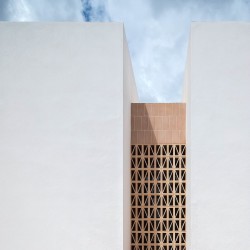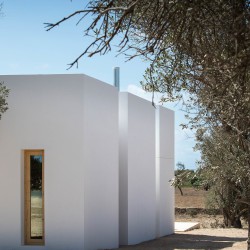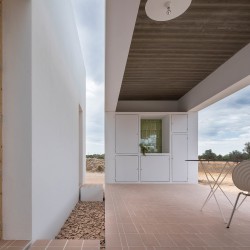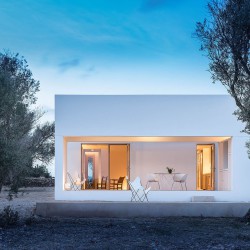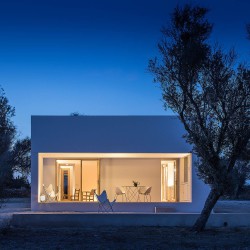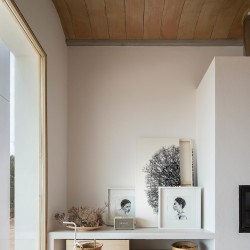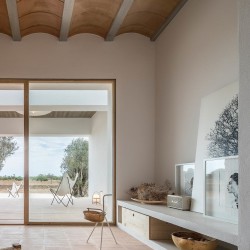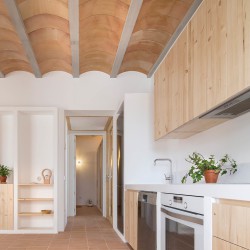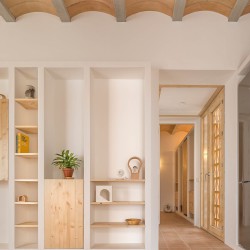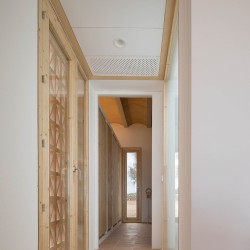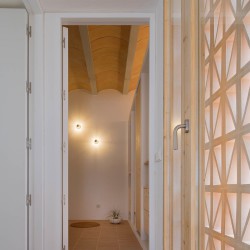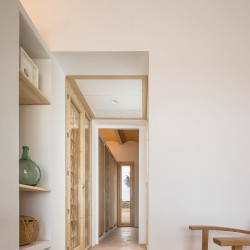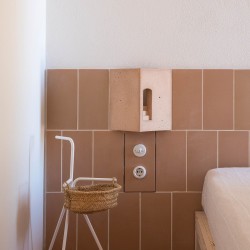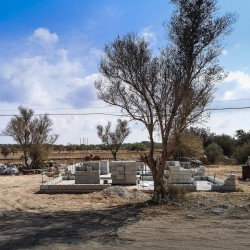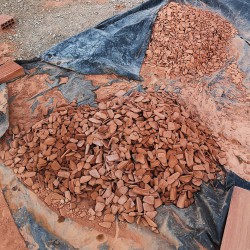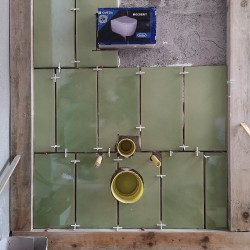Marià Castelló . photos: © Marià Castelló
“Es Pou de Can Marianet Barber” is a historical place name in the interior of the island of Formentera (Spain). A rural plot where several pre-existents condition the insertion of this small first residence in the territory. Among them, the network of centenarian dry stone walls stands out, as well as the organization of the crops. The intervention is located in the western area of the plot, parallel to a trace of more than a kilometer in length, oriented to the south and protected from the setting sun by a mass of vegetation, thus releasing the most fertile area to give continuity to the existing agricultural activity.
The proposal is divided into three volumes, which order the program while providing it with a smaller grain and in accordance with the scale of the landscape. From south to north, the first volume houses a porch that offers solar protection, the second contains the more public program, and the third two bedrooms. Among them are transverse strips that physically separate the volumes, giving them ventilation and lighting, as well as providing them with services and connections.
In front of the house, there is a cistern that makes it self-sufficient in terms of water supply while offering a solarium for the coldest months of the year.

From the inside and through the porch, deep perspectives are discovered towards the flat landscape of wheat and oat fields, where the soft and warm color of the earth and the muted greens of the almond and fig trees predominate. The light, color, and material from the outside enter the interior of the house thanks to ceramics and wood, two noble materials that are combined in a subtle and timeless way.
The warmth of the earth is transferred to the ceiling and pavements, resolved by means of Mallorcan-style ceramic vaults and pressed terracotta tiles. Likewise, the tiles are used to solve various other elements, such as façade cladding, roof finish, the headboard of the master bedroom, or pebble gravel, processing in situ the losses of the ceramic elements used. The freshness associated with the color of the vegetation predominates in the humid areas, where some vertical walls are covered with vitrified ceramic tiles of a diluted green color and identical dimensions to the rest of the pieces. The light filters inwards through its passage through ceramic lattices, generating, in turn, a constant evolution of lights and shadows.
The coherence and material harmony have led to solving with white vitrified porcelain electrical mechanisms the integration of the installations in unique places such as the headboard of the master bedroom, as well as other more common such as lamp holders and toilets. A set of lights and special pieces made by hand with formwork made in our studio have also been specifically designed for this project, seeking their chromatic and dimensional integration in the context of the coatings.
Most of the furniture has been custom-designed integrated into the architecture itself, while icons such as the Torres Clavé armchair, from 1934, or the traditional chairs from Formentera pay homage to the Mediterranean artisan tradition. Other more contemporary pieces such as the table and coffee tables from the D12 collection designed by Marià Castelló and Lorena Ruzafa for the editor Diabla Outdoor, provide a slight material and chromatic counterpoint to the set.
Architect: Marià Castelló
Construction Managers: Lorena Ruzafa + Marià Castelló
Structure Engineer: Ferran Juan Nicolau
Facilities Engineer : Javier Colomar Riera
Design Team: Lorena Ruzafa y Marga FerrerNieto Sobejano Arquitectos awarded the First Prize in the International Architectural Competition for the Archive of the Avant-garde of the Marzona Collection in Dresden

"Es Pou de Can Marianet Barber” es un topónimo histórico del interior de la isla de Formentera. Una parcela rural donde varias pre-existencias condicionan la inserción de esta pequeña primera residencia en el territorio. Entre ellas destacan la trama de muros de piedra seca centenarios así como la organización de los cultivos. La intervención se ubica en la zona oeste de la parcela, paralela a una traza de más de un quilómetro de longitud, orientada a sur y protegida del sol de poniente por una masa de vegetación, liberando así la zona más fértil para dar continuidad a la actividad agrícola existente. La propuesta se fragmenta en tres volúmenes, que ordenan el programa a la vez que lo dotan de un grano más pequeño y acorde con la escala del paisaje. De sur a norte, el primer cuerpo aloja un porche que ofrece protección solar, el segundo contiene el programa de carácter más público y el tercero dos dormitorios. Entre ellos se encuentran franjas transversales que separan físicamente los volúmenes aportándoles ventilación e iluminación así como dotándolos de servicios y conexiones. Delante de la vivienda se ubica un aljibe que la hace autosuficiente en términos de abastecimiento de agua a la vez que ofrece un solárium para los meses más fríos del año. Desde el interior y a través del porche se descubren perspectivas profundas hacia el llano paisaje de campos de trigo y avena, donde predomina el suave y cálido color de la tierra y los verdes apagados de los almendros e higueras. La luz, el color y la materia del exterior se adentran en el interior de la vivienda de mano de la cerámica y la madera, dos materiales nobles que se combinan de manera sutil y atemporal. La calidez de la tierra se traslada al techo y pavimentos, resueltos mediante bovedillas cerámicas de tipo mallorquín y baldosas de terracota prensada. Asimismo, las baldosas se utilizan para resolver diversos elementos más, tales como revestimientos de fachada, acabado de cubierta, el cabecero del dormitorio principal, o grava de canto rodado, procesando in situ las mermas de los elementos cerámicos utilizados. El frescor asociado al color de la vegetación predomina en las zonas húmedas, donde algunos paramentos verticales se revisten con baldosa cerámica vitrificada de color verde diluido e idénticas dimensiones que el resto de piezas. La luz se tamiza hacia el interior a través de su paso por celosías cerámicas, generando a su vez un devenir constante de luces y sombras. La coherencia y harmonía material ha llevado a resolver con mecanismos eléctricos de porcelana vitrificada blanca la integración de las instalaciones en lugares singulares como el cabecero del dormitorio principal, así como otros más comunes como portalámparas y sanitarios. También se han diseñado específicamente para este proyecto un conjunto de luminarias y piezas especiales realizadas artesanalmente con encofrados hechos en nuestro estudio, buscando su integración cromática y dimensional en el contexto de los revestimientos. Guarda esta imagen en tus favoritosCortesía de Marià CastellóCortesía de Marià Castelló La mayor parte del mobiliario se ha diseñado a medida integrado en la propia arquitectura, mientras iconos como la butaca Torres Clavé, de 1934, o las sillas tradicionales de Formentera rinden homenaje a la tradición artesanal mediterránea. Otras piezas más contemporáneas como la mesa y mesitas de la serie D12 diseñadas por Marià Castelló y Lorena Ruzafa para Diabla Outdoor, aportan un ligero contrapunto material y cromático al conjunto.











